Lesson Contents
BGP connections to ISPs use four main topology designs:
- Single-Homed
- Dual-Homed
- Single Multi-Homed
- Dual Multi-Homed
These are different design topologies where we describe how a customer is connected (using BGP) to one or more ISPs. In this lesson, we’ll take a look at each topology, and I’ll explain what they are and what we use them for.
Key Takeaways
- Single-homed: One connection to one ISP. It’s simple and low-cost but offers no redundancy.
- Dual-homed: Two or more connections to a single ISP. This adds link or router redundancy but still relies on one provider.
- Single multi-homed: A single connection to two or more different ISPs. This provides provider redundancy but may have single points of failure if you only use a single router.
- Dual multi-homed: Two or more connections to two or more different ISPs. This design offers the highest level of redundancy but also the most expensive and complex option.
Single Homed
The single homed design means you have a single connection to a single ISP. With this design, you don’t need BGP since there is only one exit path in your network. You might as well just use a static default route that points to the ISP.
The advantage of a single-homed link is that it’s cost effective, the disadvantage is that you don’t have any redundancy. Your link is a single point of failure but so is using a single ISP.

Dual Homed
The dual homed connection adds some redundancy. You are still only connected to a single ISP, but you use two links instead of one. There are some variations for this design. Here’s the first one:

With this design, we use a single router on both ends, but we do have redundant links.
To increase redundancy, we can add a second router:
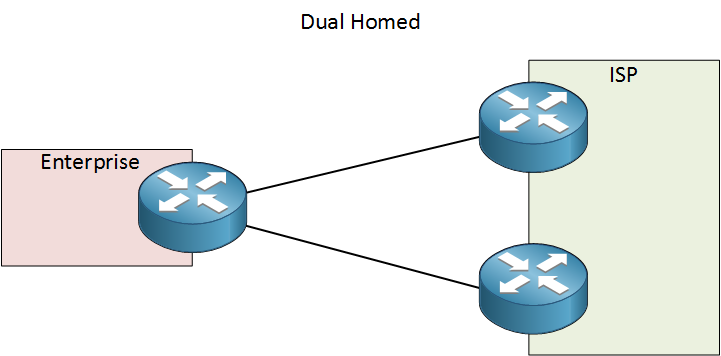
In the example above, the ISP has a second router. We also could have used a second router at the customer’s side and a single router at the ISP. For even more redundancy, add a second router at both sides:
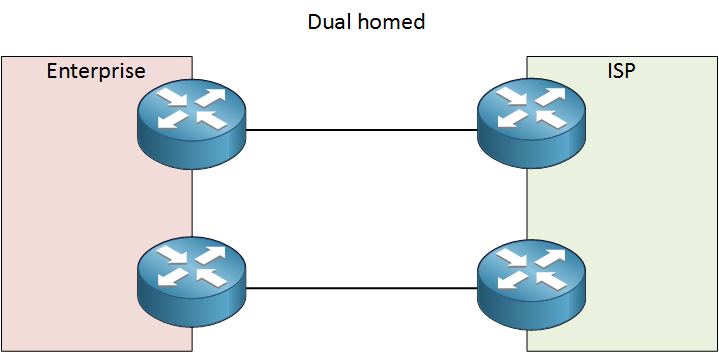
The example above offers the most redundancy when you are connected to a single ISP. We have two links and two routers on both ends. One disadvantage of this design is that we are still using a single ISP.
Single Multi-homed
Multihomed means we are connected to at least two different ISPs. The most simple design looks like this:
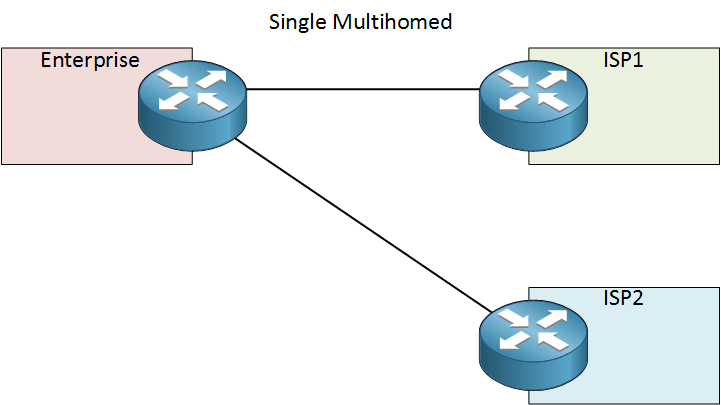
Above you see that we have a single router at the customer, connected to two different ISPs. The single point of failure in this design is that you only have one router at the customer. When it fails, you won’t be able to connect to any ISP. We can improve this by adding a second router:
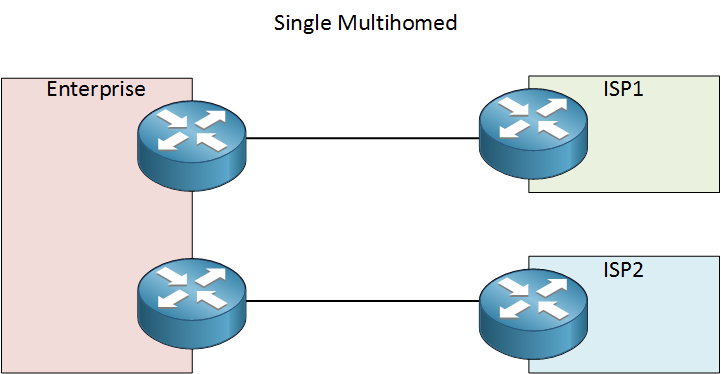
This is a pretty good design, we only use single links, but we are connected to two different ISPs using different routers.
Dual Multihomed
The dual multihomed designs means we are connected to two different ISPs, and we use redundant links. There are some variations, here’s the first one:
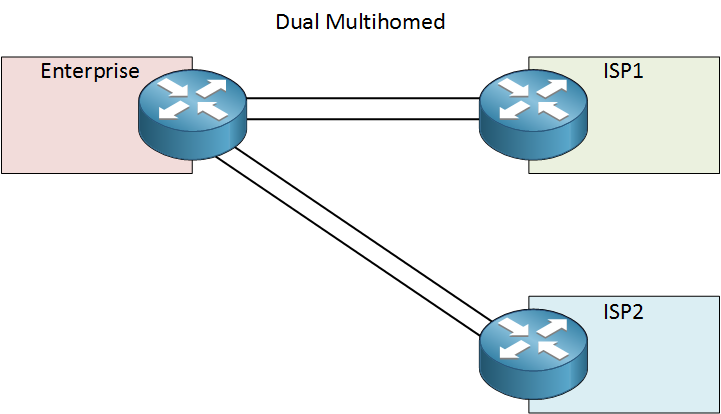
Above you can see that we are connected to two different ISPs, using one router and two links to each ISP. We have redundant ISPs and links, but the router is still a single point of failure. We can improve this by adding a second router:


Does the Dual home method 2 and method 3 varies in costs to the enterprise? or same?
Thanks,
Srini
Hello Srinivasan
The Dual homed method 2 involves two separate ISP routers from the SAME ISP. This would most likely increase the cost of the solution compared to method 1 because of the fact that you require your ISP to provide you with two pieces of equipment on their end.
Method 3 would most likely be even more expensive, because you are purchasing connectivity to two DIFFERENT ISPs, so you can’t take advantage of any discounts the single ISP may give you for multiple links.
What I’m describing is the most probable case concerning cost. Ultimately it depen
... Continue reading in our forumHey,
is it possible to run also VRRP/HSRP with 2 BGP customer Edge Routers to 1 ISP-Router and be like Dual Homed then? Is there a documentation for that?
I mean 1 public IP shared with Failover by 2 Routers.
In Detail i would give a loopback the public IP and do OSPF between ISP and Customer(HSRP)
Best regards
Alex
Hello Alexander
In order to run a redundancy gateway protocol on two edge routers with a single ISP router, you’d need some infrastructure between the edge routers and the ISP routers like a switch. It is possible, but this would introduce a new single point of failure and this is not desired especially on the edge of the network.
https://cdn-forum.networklessons.com/uploads/default/original/2X/a/a3aba10cfedb22063e8a63aaac5774f1408f0fad.png
That would also mean that if your edge routers are performing NAT, you would require three public IP addresses, one for e... Continue reading in our forum
Wow, a great and detailed response. I see my Problem in understanding now.
So any of these are not recommended
So better redundancy with 2 own Routers and 1 Provider Router would be via having a link for each own router to the Provider Router and using AS Path for advertising the backup path via the standby router?